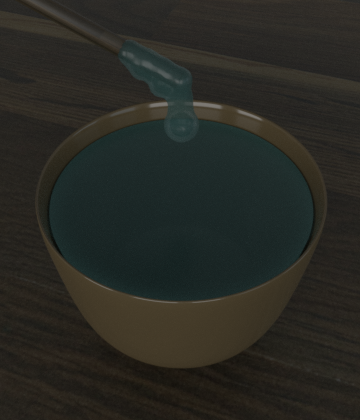Hénéphgýa Resin
The resin produced by the Hénéphgýa plant.
Properties
Material Characteristics
Fresh resin is a sticky, viscous liquid of a bluish-green color. It starts semi-transparent and becomes more opaque as it dries and solidifies.
Physical & Chemical Properties
In its liquid state, the resin contains high amounts of flammable ethereal oils. When these oils evaporate, a semi-flexible substance remains. The resin is soluble in oils and to some degree in alcohol, but not in water.
Dry resin is non-conductive to electricity.
Origin & Source
The material is harvested from Hénéphgýa trees by cutting the bark and letting the resin trickle into glazed clay pots.
Alternatively, dried lumps of resin can be collected, crushed and dissolved in oil. However, this second-hand resin is of a poorer quality and often includes particles of wood, lichens or dead insects.
Life & Expiration
The resin becomes dry to the touch after being left in the open air for a few minutes. It eventually solidifies completely, at a rate depending on the thickness of the sample and the surrounding temperature.
History & Usage
Everyday use
Using the resin to seal open wounds goes back to pre-historic times, and even today it still plays an important role in medicine. The basic idea has changed very little over the ages. Cuts or tears in the skin are cleaned, pressed together and covered with a thin layer of fresh resin. When the resin has started to dry, a strip of fabric is wrapped around the body part to keep the wound compressed and serve as additional protection.
The effect of the resin is two-fold. On one hand, it creates a water-proof physical barrier which stops the bleeding and prevents dirt from entering the wound. On the other hand, the ethereal oils in the resin are known to prevent infections.
Cultural Significance and Usage
Dried lumps of resin still contain a notable amount of ethereal oils which can be released by heating and melting the material. Additionally, various types of incense are made by dissolving those lumps and mixing them with other fragrant ingredients such as herbs and flower petals. This incense is traditionally burnt during religious ceremonies, both in temples and household shrines.
Industrial Use
The resin cannot be removed with water, and thin layers retain some flexibility after drying. These properties make it ideal for water-proofing various surfaces.
Examples include:
fabrics for tents, umbrellas and rain coats
wooden barrels and ship rumps
electrical wiring and casings
Byproducts & Sideproducts
Heat is often applied to accelerate the evaporation of the ethereal oils. Since these oils are a valuable resource in their own right, efforts are usually made to preserve them via condensation. Besides their use in medical ointments, they are a popular component of perfumes, soaps and bath additives.
Hazards
Fresh resin is flammable due to the high content of volatile oils. Ingesting large amounts of those oils can lead to stomach cramps and diarrhea, which is why the coating in wooden barrels has to dry thoroughly before it may come in contact with food or drinks.
Reusability & Recycling
Dry resin can be dissolved in lipids such as plant oils and animal fats. Without the original essential oils, it is less attractive for medical or cosmetic purposes, but still useful for industrial applications.
Distribution
Trade & Market
Hénéphgýa trees are cultivated in the tropical zones of Gysuphun. From there, the resin is sold throughout the Nimýric Empire.
Storage
The resin is commonly stored in wooden barrels. Part of it seeps through the wood and dries up, keeping most of the essential oils from escaping. Nevertheless, it is advisable to use the contents of the barrel within a year.
Type
Polymer
Value
high
Rarity
common
Odor
sweet, spicy (fresh)
odorless (dried)
odorless (dried)
Color
teal
Common State
liquid (fresh)
solid (processed/applied)
solid (processed/applied)
Related Species






Comments